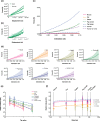Allometric scaling of skin thickness, elasticity, viscoelasticity to mass for micro-medical device translation: from mice, rats, rabbits, pigs to humans
- PMID: 29162871
- PMCID: PMC5698453
- DOI: 10.1038/s41598-017-15830-7
Allometric scaling of skin thickness, elasticity, viscoelasticity to mass for micro-medical device translation: from mice, rats, rabbits, pigs to humans
Abstract
Emerging micro-scale medical devices are showing promise, whether in delivering drugs or extracting diagnostic biomarkers from skin. In progressing these devices through animal models towards clinical products, understanding the mechanical properties and skin tissue structure with which they interact will be important. Here, through measurement and analytical modelling, we advanced knowledge of these properties for commonly used laboratory animals and humans (~30 g to ~150 kg). We hypothesised that skin's stiffness is a function of the thickness of its layers through allometric scaling, which could be estimated from knowing a species' body mass. Results suggest that skin layer thicknesses are proportional to body mass with similar composition ratios, inter- and intra-species. Experimental trends showed elastic moduli increased with body mass, except for human skin. To interpret the relationship between species, we developed a simple analytical model for the bulk elastic moduli of skin, which correlated well with experimental data. Our model suggest that layer thicknesses may be a key driver of structural stiffness, as the skin layer constituents are physically and therefore mechanically similar between species. Our findings help advance the knowledge of mammalian skin mechanical properties, providing a route towards streamlined micro-device research and development onto clinical use.
Conflict of interest statement
The authors declare that they have no competing interests.
Figures




Similar articles
-
The viscoelastic, hyperelastic and scale dependent behaviour of freshly excised individual skin layers.Biomaterials. 2011 Jul;32(20):4670-81. doi: 10.1016/j.biomaterials.2011.03.012. Epub 2011 Mar 31. Biomaterials. 2011. PMID: 21458062
-
Effect of dermal thickness, tissue composition, and body site on skin biomechanical properties.Skin Res Technol. 2006 Feb;12(1):43-9. doi: 10.1111/j.0909-725X.2006.00135.x. Skin Res Technol. 2006. PMID: 16420538 Clinical Trial.
-
Elastic modulus and viscoelastic properties of full thickness skin characterised at micro scales.Biomaterials. 2013 Mar;34(8):2087-97. doi: 10.1016/j.biomaterials.2012.11.035. Epub 2012 Dec 20. Biomaterials. 2013. PMID: 23261214
-
Computational and experimental characterization of skin mechanics: identifying current challenges and future directions.Wiley Interdiscip Rev Syst Biol Med. 2013 Sep-Oct;5(5):539-56. doi: 10.1002/wsbm.1228. Epub 2013 Jun 11. Wiley Interdiscip Rev Syst Biol Med. 2013. PMID: 23757148 Review.
-
Relationship between tendon stiffness and failure: a metaanalysis.J Appl Physiol (1985). 2013 Jul 1;115(1):43-51. doi: 10.1152/japplphysiol.01449.2012. Epub 2013 Apr 18. J Appl Physiol (1985). 2013. PMID: 23599401 Free PMC article. Review.
Cited by
-
Design of an Integrated Microvascularized Human Skin-on-a-Chip Tissue Equivalent Model.Front Bioeng Biotechnol. 2022 Jul 19;10:915702. doi: 10.3389/fbioe.2022.915702. eCollection 2022. Front Bioeng Biotechnol. 2022. PMID: 35928950 Free PMC article.
-
Effect of Subnormothermic Machine Perfusion on the Preservation of Vascularized Composite Allografts After Prolonged Warm Ischemia.Transplantation. 2024 Nov 1;108(11):2222-2232. doi: 10.1097/TP.0000000000005035. Epub 2024 Oct 22. Transplantation. 2024. PMID: 38722685
-
Smart Nanofibers with Natural Extracts Prevent Senescence Patterning in a Dynamic Cell Culture Model of Human Skin.Cells. 2020 Nov 24;9(12):2530. doi: 10.3390/cells9122530. Cells. 2020. PMID: 33255167 Free PMC article.
-
Objective Noninvasive Measurement of the Volumizing Effect of a Dermal Filler: An In Vivo Study.Aesthetic Plast Surg. 2024 Oct;48(19):4024-4030. doi: 10.1007/s00266-024-04138-3. Epub 2024 May 28. Aesthetic Plast Surg. 2024. PMID: 38806832 Free PMC article.
-
Human relevance of in vivo and in vitro skin irritation tests for hazard classification of pesticides.Cutan Ocul Toxicol. 2025 Mar;44(1):1-21. doi: 10.1080/15569527.2024.2387596. Epub 2024 Aug 24. Cutan Ocul Toxicol. 2025. PMID: 39180341 Review.
References
-
- Kendall MA. The delivery of particulate vaccines and drugs to human skin with a practical, hand-held shock tube-based system. Shock Waves. 2002;12:23–30. doi: 10.1007/s001930200126. - DOI
-
- Cheung, K. & Das, D. B. Microneedles for drug delivery: trends and progress. Drug Deliv 1–17 (2016). 10.3109/10717544.2014.986309. - PubMed
MeSH terms
LinkOut - more resources
Full Text Sources
Other Literature Sources

